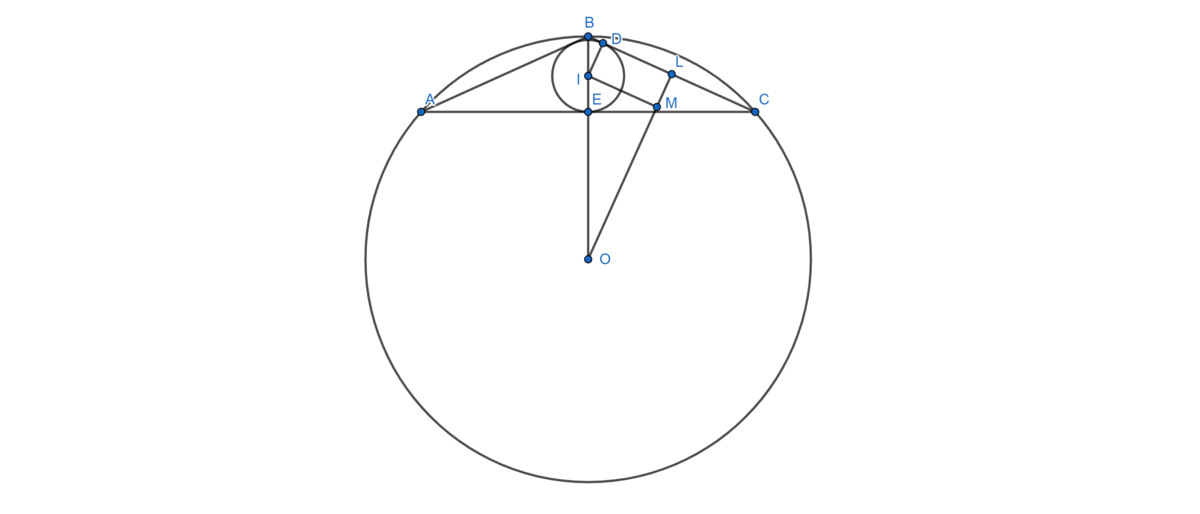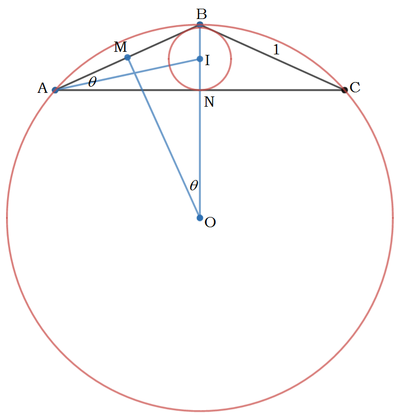Three Aces
Two sides of a triangle, as well as the distance between its incenter and circumcenter , all have the value of 1 . What is the area of the triangle? If it can be expressed as q p , where p and q are coprime, submit p + q .
The answer is 11.
This section requires Javascript.
You are seeing this because something didn't load right. We suggest you, (a) try
refreshing the page, (b) enabling javascript if it is disabled on your browser and,
finally, (c)
loading the
non-javascript version of this page
. We're sorry about the hassle.
3 solutions
Well done, Thanos.

Let the incircle of △ B A C touch sides B C & C A at points D & E respectively. Draw I D & I E . Drop perpendicular from O on B C meeting B C at L . Points B , I , E & O will be collinear since △ B A C is isosceles. Draw the line containing them.
Drop perpendicular from I on O L meeting O L at M .
Observe that, in
△
I
M
O
&
△
B
E
C
,
I
O
=
B
C
=
1
,
∠
I
M
O
=
∠
B
E
C
&
∠
M
I
O
=
∠
E
B
C
. Thus
△
I
M
O
≅
△
B
E
C
by
A
−
S
−
A
criterion of congruency.
⇒
B
E
=
I
M
Let C A = 2 a . ⇒ E C = 2 1 ⋅ 2 a = a
I M = D L [ Since I M L D is a rectangle ]
= D C − L C
= E C − 2 1 B C = a − 2 1
Thus, B E = I M = a − 2 1
Applying the Pythagorean theorem on △ B E C gives ,
B E 2 + E C 2 = B C 2
⇒ ( a − 2 1 ) 2 + a 2 = 1 ⇒ 2 a 2 − a = 4 3
Therefore, area of △ A B C = 2 1 ⋅ A C ⋅ B E = E C ⋅ B E = a ( a − 2 1 ) = 2 1 ( 2 a 2 − a ) = 2 1 × 4 3 = 8 3
p = 3 , q = 8 ⇒ p + q = 1 1

Let the isosceles triangle be A B C with A B = B C = 1 , the midpoints of A B and A C be M and N , the incenter be I , and the circumcenter be O . We note that O M is perpendicular to A B and I O bisects A C perpendicularly at N .
We note that ∠ B A C = ∠ B O M = θ . Then I N = A N ⋅ tan 2 θ = cos θ tan 2 θ . And B O = B M ⋅ csc θ = 2 sin θ 1 . Then we have:
I O 1 1 1 4 t ⟹ 3 t 2 = B O − B N + I N = 2 sin θ 1 − sin θ + cos θ tan 2 θ = 4 t 1 + t 2 − 1 + t 2 2 t + 1 + t 2 t ( 1 − t 2 ) = 4 t 1 + t 2 − t = 1 + t 2 − 4 t 2 = 1 − 4 t Let t = tan 2 θ
The area of △ A B C :
[ A B C ] = sin θ cos θ = 1 + t 2 2 t ⋅ 1 + t 2 1 − t 2 = ( 3 + 3 t 2 ) 2 1 8 t ( 1 − t 2 ) = 1 6 ( 1 − t ) 2 1 8 t ( 1 − t 2 ) = 8 ( 1 − t ) 9 t ( 1 + t ) = 8 ( 1 − t ) 9 t + 9 t 2 = 8 ( 1 − t ) 3 − 3 t = 8 3
Therefore p + q = 3 + 8 = 1 1 .
For the area A of △ A B C we have A = 4 R a b c = s r where s is the semiperimeter of the triangle. Thus, we get 4 R 1 ⋅ 1 ⋅ c = 2 1 + 1 + c r ⇔ r R = 2 c + 4 c ( 1 )
According to Euler's theorem in geometry it holds that I O 2 = R ( R − 2 r ) From this we get
R 2 − 2 r R = 1 ⇒ R 2 = 1 + 2 r R ⇒ ( 1 ) R 2 = 1 + 2 2 c + 4 2 ⇒ R = c + 2 2 c + 2 ( 2 ) On our way to build an equation for c , we have
A = 2 1 a b sin C A = 4 R a b c ⎭ ⎪ ⎬ ⎪ ⎫ ⇒ 2 1 a b sin C = 4 R a b c ⇒ ( 2 ) 2 sin C = 4 c + 2 2 c + 2 c ⇔ 4 sin 2 C = 2 c + 2 c 2 ( c + 2 ) ⇔ 4 ( 1 − cos 2 C ) = 2 c + 2 c 3 + 2 c ( 3 )
From Cosine Rule
cos C = 2 a b a 2 + b 2 − c 2 ⇒ cos C = 2 2 − c 2 ( 4 )
Combining,
( 3 ) , ( 4 ) ⇒ 4 ( 1 − ( 2 2 − c 2 ) 2 ) = 2 c + 2 c 3 + 2 c Rearranging, we get
2 c 5 + 2 c 4 − 7 c 3 − 6 c 2 = 0 ⇔ c = 0 2 c 3 + 2 c 2 − 7 c − 6 = 0 ⇔ ( c + 2 ) ( 2 c 2 − 2 c − 3 ) = 0 ⇔ c > 0 c = 2 1 + 7 Plugging this value in A = 4 R a b c = 4 c + 2 2 c + 2 c yields A = 8 3 . For the answer, p + q = 3 + 8 = 1 1 .